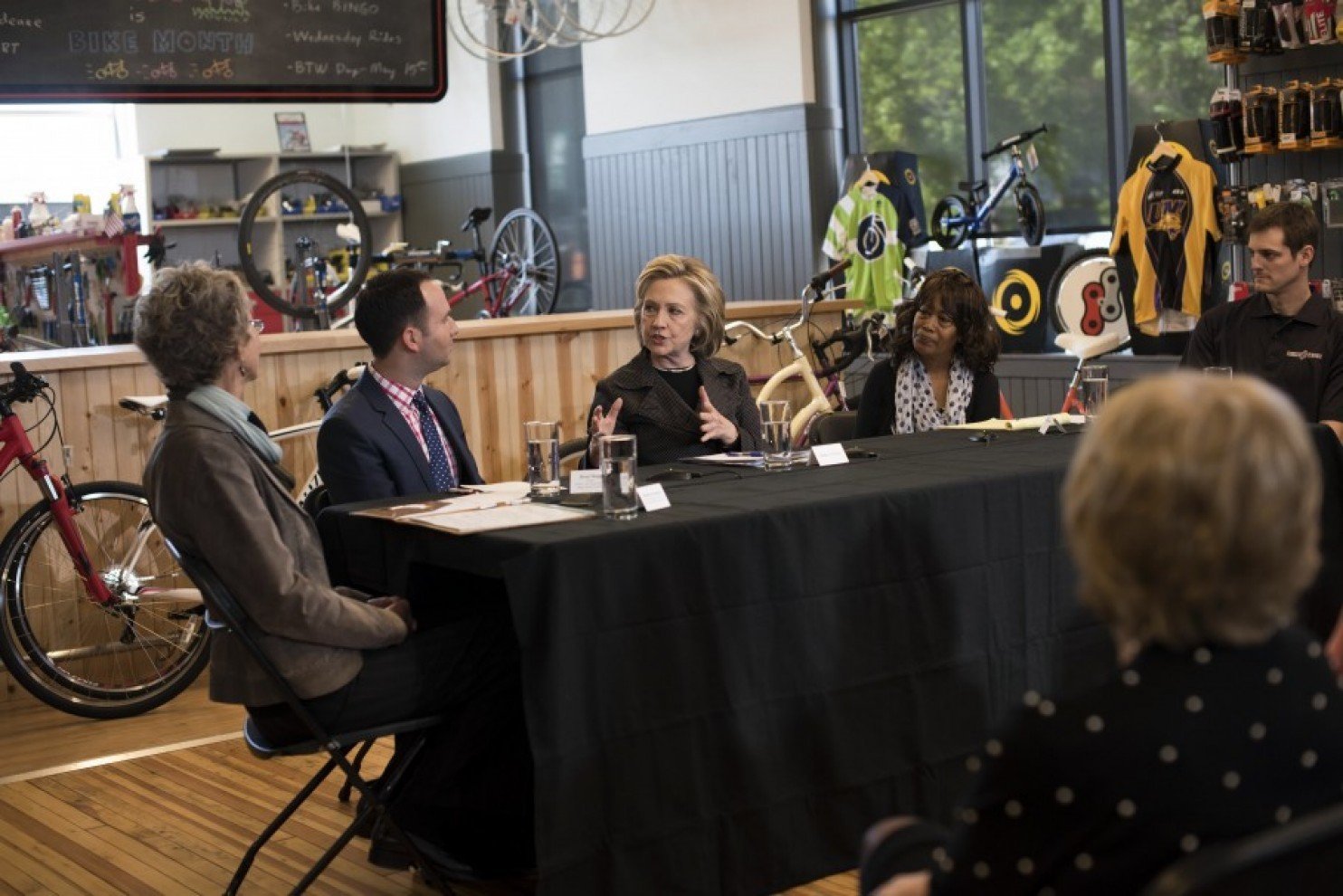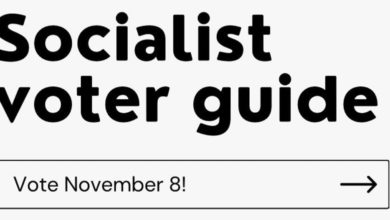 “Well, let me just follow-up on that, Anderson, because when I think about capitalism, I think about all the small businesses that were started because we have the opportunity and the freedom in our country for people to do that and to make a good living for themselves and their families.”
“Well, let me just follow-up on that, Anderson, because when I think about capitalism, I think about all the small businesses that were started because we have the opportunity and the freedom in our country for people to do that and to make a good living for themselves and their families.”
-Hillary Clinton
Hillary Clinton, in the first Democratic presidential debate, hit on one of the biggest myths in U.S. politics. U.S. capitalism is the best system because at its heart is “small business” and that this “entrepreneurial spirit” is central to the “American ” ethos. What is most notable about this is that small business is actually a very small part of the economy. The U.S. economy in fact is totally dominated by monopoly corporations.
If, however, we are a “nation of shopkeepers” then ability to “pull oneself up by one’s bootstraps” and become rich and successful should be able to happen outside of the movies. In Clinton’s presentation this can-do spirit and the “freedom” that accompanied it created the U.S. “middle class.”
That the self-professed democratic socialist Bernie Sanders followed up with a paean to “entrepreneurial spirit” shows how deeply this small business mythology pervades popular understanding of the economy.
What is the substance of this myth?
A nation of shopkeepers?
There is some sense to the idea small business is the “heart” of the U.S. economy, given that there are many more small businesses than large businesses. In fact in the private sector 97 percent of businesses have fewer than 100 employees. However the true picture is further revealed when one notes that while businesses that have over 1,000 employees represent only 0.21 percent of the businesses, they employ 40 percent of the people working in the entire country.
The raw number of workers in enterprises with more than 1,000 employees, about 45 million, is greater than the number of people working in all businesses
with fewer than 100 employees.
In the various U.S. manufacturing industries like auto or steel, in roughly 40 percent of them the four largest firms account for at least 50 percent of the business activity. Some 73 percent of computer and software stores are owned by the largest four brands in that industry. Likewise in the retail sector that includes stores such as Target and Wal-Mart, 73 percent of its activity controlled by just the four market leaders.
Even in sectors that appear to have a decent amount of variety, a handful of firms dominate production. Some 32 percent of the supermarket business is controlled by the top four companies (up from 18 percent in 1992), while just one company accounts for 20 percent of all coffee sales in the U.S.
Capital is, of course, transnational, and many of the largest companies monopolize the global economy not just the U.S. economy. In 2011 a group of Swiss researchers studied what they deemed to be all 43,000 transnational corporations. They found that 147 firms with interlocking ownership of each other controlled 40 percent of the total wealth of all transnational corporations, and 737 firms controlled 80 percent.
If all that is not enough it further goes to make the point that the top 200 firms in the United States—out of 27 million—accounted for roughly 30
percent of the gross revenue and profits of the entire group.
In reality, the vast majority of people who work for wages work for larger corporations; almost every sector of the economy, as well as the economy as a whole, on a national and global scale, is dominated by a small minority of massive firms.
Small business operates primarily either as a supply-chain adjunct to, or in the crevasses, between large corporations.
Path to the middle class?
The “middle class” itself is something of a myth, so loosely defined that someone making $35,000 or $500,000 could both think they were in it. This is because “middle class” is defined as a level of income, essentially being enough disposable income to participate in mass consumer society in some meaningful way.
The mass consumer society at the center of the small business mythology was most decidedly not created by small businesses. This narrative was first used for political propaganda by Herbert Hoover with his “Chicken in every pot and car in every backyard,” then with the later and more all-encompassing “suburban living” that emerged after World War II.
The basis of this culture was the harnessing by huge industries of new “scientific” production techniques and assembly-line capabilities to produce an increasing number of products in the tens of millions, profitably. It also meant the increasing growth of state expenditures and agencies in augmenting and backstopping this new reality. (Michel Aglietta, A Theory of Capitalist Regulation: The U.S. Experience)
The reality is, however, this mass consumer culture did not create a large amount of economic mobility. Over most of the second half of the twentieth century the chances from moving to the bottom fifth to the top fifth of the income distribution wasn’t going to be more than 10 percent meaning there weren’t that many rags-to-riches stories.
So again, not only was the “middle class” standard of living not brought about by small business, but also—even during the “golden years” of the 1950s—there never was much inter-class mobility, that was no “pathway” to the middle class.
Economic reality
The only way to really explain this is to throw away the clearly inadequate conception of “middle class.” Marxists use a more precise definition of “class.” Your class is determined by your relationship to the economy. Do you have to sell your ability to do something to someone else to survive? If so you are in the “working class.” Or do you own an asset (other than your labor) which can “generate an income stream” for you?
The working class is larger and more variegated than its caricature of middle-aged white factory workers. It is essentially the bulk of society in all its varieties.
As the studies in economic mobility suggest, class distinctions are fairly rigid in the United States. It is not so much class location that fluctuates, as our perception of what it means. The popular feeling that there is less mobility is because there is less prosperity. Capitalism isn’t narrowing the gap between rich and poor but expanding it. You may be in the same place but the finish line now appears further away.
It is worth noting here the very idea of the “American Dream” middle class standard of living is mostly a snapshot of a very particular part of the economy at a very particular place in time: when jobs and suburban homes were largely not available to Blacks and women played an extremely limited role in the economy. The same research that shows little variation in economic mobility over time also finds that geographic trends reveal certain regions have more variable levels of economic mobility than others within the United States.
A clear reflection of the divergence between the “American Dream” and reality can be seen in the legacies of slavery and Jim Crow, the oppression of women, redlining in homeownership, and so on. The geographic differences in mobility speaks to the fact that capitalism in the U.S. isn’t simply some monolith but a system of exploitation that through its own trials and tribulations has constructed a complicated set of relations.
What’s key isn’t really so much the differences between people, which as the recent focus in social movements in “identity” have revealed, are numerous and intersecting. But what is important is that most people exist somewhere along the non-decision making end of the value chain of a handful of corporations controlled by a tiny group of people.
Odds are, the social milieu you’re born into is most likely the one in which you will live your whole life. The most powerful unifying factor that cuts across the working class (however we may identify) is the inability to have any real control over our lives. We essentially manage them within these broad limits.
This is why the mythology around small business is important. It reinforces the central idea that “if you work hard, you can succeed.” It gives the impression of a dynamic system in which “anyone can make it.” When the reality is: it is a system dominated by a handful of monopolies, their owners bloated with wealth. Odds are you are going to stay right where you are.
The fact that we live in a monopoly capitalist society is fairly obvious, hence the hard work that is put into perpetuating myths about the system. First we must discard the myths, then learn their lesson. Whatever other differences exist, and they must be addressed, the vast majority of people have a unified interest in opposing the interests of the system that uses the ownership of a few to exploit the many.
Eugene Puryear is the Vice-Presidential candidate of the Party for Socialism and Liberation, running alongside Gloria LaRiva for President. Learn more at VotePSL.





